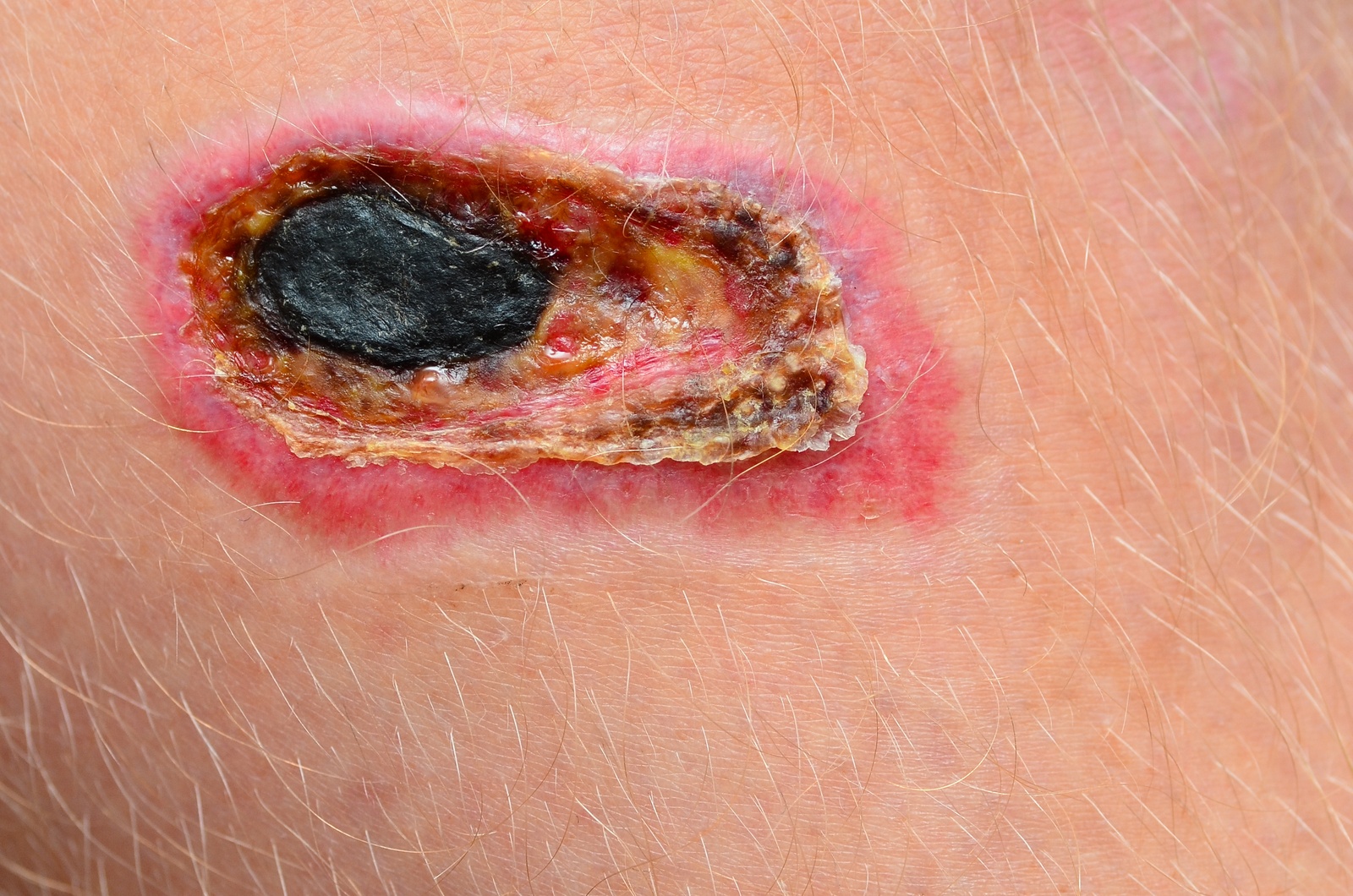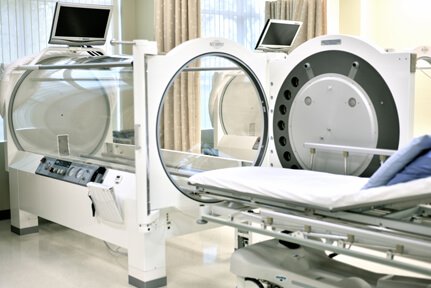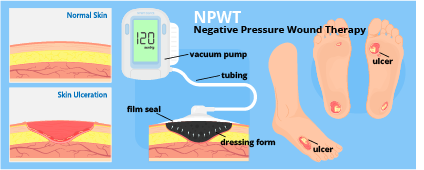
We focus on advanced treatments that stop the infection in its tracks, while preserving as much function as possible. We will determine your specific treatment plan based on your age, medical history and overall health.
schedule an appointmentOur staff is board-certified and includes a team of doctors, registered nurses and physicial therapists who are specialized in
non-healing wounds. We can diagnose and design wound care programs for people with various wounds types.
Our comprehensive wound care offers extensive expertise, advanced technologies and state-of-the-art treatments for managing and healing - hard-to-heal wounds.

Whenever you have a wound, whether it’s a minor cut or a major incision, it’s crucial to care for it properly. Part of the process includes wound care dressings. There are a variety of options when it comes to dressings, and to determine which is the best and most effective depends on what sort of wound you have.
Advanced wound dressings includes film and foam dressings, hydrogels, alginates, hydrocolloids and collagens. Such products are largely focused on keeping the wound hydrated to encourage healing, a moist micro-environment promotes the natural healing process since human cells require water to live and grow without occluding the wound. Along with maintaining a hydrated environment, advanced wound dressings products may:
Keep temperatures consistent
Allow flow of oxygen
Protect the site from exogenous infection
Remove dead tissue
Ease pain associated with dressing changes

Your skin protects your body from various pathogens. A wound is an opportunity for bacteria and other microorganisms to enter your body and cause problems like inflammation and tissue damage. An infection can start in a wound within a couple of days. The risk of infection is present until the wound heals.
For most infected wounds, you should seek medical treatment. Doctors frequently prescribe antibiotics for wound infection, including:
Amoxicillin-clavulanate (Augmentin, Augmentin-Duo)
Cephalexin (Keflex)
Clindamycin (Cleocin)
Dicloxacillin
Doxycycline (Doryx)
Trimethoprim-sulfamethoxazole (Bactrim, Septra)

What is bioengineered skin? Bioengineered skin consists of an outer epidermal layer and/or a dermal layer (the layer of skin between the epidermis and the subcutaneous tissue) embedded into an acellular matrix (a support structure) forming a biological skin substitute.
Skin substitutes are used to help:
Close wounds
Reduce pain
Promote healing
Eliminate the need for surgical skin grafts
The bioengineered skin substitutes used at CAWC closely resemble human skin in structure and function, and they can be used temporarily or permanently. In wound healing, skin substitutes can be used for patients with:
Venous leg wounds
Burns
Diabetic foot wounds
Non-healing surgical wounds
Other chronic wounds

Compression therapy is a simple and effective means of increasing blood flow activity in the lower limbs through strengthening vein support. It’s a form of wound care that aims to gently apply pressure to the ankles and legs by wearing specifically designed stockings. These dressings then work to slowly stretch out vein walls and improve overall circulation, which in turn helps eliminate swelling.
Sufferers of chronic venous disease are the main candidates for compression therapy. Chronic venous diseases arise in people increased pressure strains the leg veins, which can prompt valves within the veins to fail to work efficiently, resulting in blood flow to back up and eventually pool out in the legs. Chronic venous diseases can occur in any patients who have experienced one or more of the following:
Leg injury or surgery
Excessive weight gain or obesity
Prolonged periods without movement
Blood clots in the veins
Without effective compression therapy, chronic venous diseases can lead to future issues. One of the biggest side effects are dilated veins, or “spider veins.” These begin to appear as thin blue lines that can branch out depending on the severity of the blood flow restriction. Dilated veins will drain your limbs and produce heavy periods of fatigue, which can eventually lead to sudden bursts of pain. Compression therapy is a primary source of treatment that can help alleviate aching and loosen constriction between the vein walls.

Debridement is the process of removing unhealthy tissue from the body. The tissue may be necrotic (dead), infected, damaged, contaminated or there may be a foreign body in the tissue. While it can be painful, many wounds would not heal without this essential process. There are a wide variety of debridement techniques used for a severe wound or difficult to heal wound, and multiple types of these treatments may be used in healing a wound. Types of Debridement includes:
Autolytic Debridement: This is the body's own process of getting rid of dead tissue and keeping healthy tissue. This process may be assisted by a dressing or wound care, but this type of debridement is essentially standing back and allowing the body to heal itself.
Enzymatic Debridement: Uses enzyme solutions or ointments to treat the tissue. Typically, the solution or ointment is combined with a dressing that is changed regularly, which softens the tissue and allows for the bad tissue to be removed when the dressing is removed.
Mechanical Debridement: Removal of tissue using a dressing that is changed regularly. The dressing commonly referred to as a wet to dry dressing, consists of moist gauze being applied to a wound that requires debridement, which is then covered with a sterile bandage. After a set period of time, the dressing will dry out, which allows the tissue to adhere to the gauze. When the dressing is removed, the tissue that adhered to the gauze is also removed.
Hydrotherapy (Mechanical) Debridement: Hydrotherapy, or pressurized water, is most commonly used to debride burn wounds. A non-selective form of debridement, this treatment can be very painful, depending upon the nature of the wounds.

Also known as HBOT, is a medical treatment that delivers 100% oxygen to a patient’s pulmonary system while they are within a pressurized chamber. Basically, the patient is breathing oxygen at levels far greater than that which is found at a normal room atmosphere.
HBOT allows more life-sustaining oxygen to be delivered to the tissues and organs. This increase of the partial pressure of oxygen at the cellular level accelerates the healing processes and assists in the recovery from numerous indications. HBOT is SAFE. Side effects are minimal and rarely last a long time. Hyperbaric Oxygen is not a cure to most indications but it has been clearly demonstrated to dramatically increase immune capabilities, assisting patients with problems ranging from chronic wounds to complex disabilities and neurological impairment.
Air or Gas Embolism | Carbon Monoxide Poisoning
Compromised Skin Grafts or Flaps
Crush Injury, Compartment Syndrome
Decompression Sickness (Bends)
Diabetic & other Non-healing Wounds
Enhancement of Healing in Selected Problem Wounds
Exceptional Anemia: Resulting of Bleeding
Gas Gangrene | Intracranial Abscess
Osteomyelitis | Radiation Injury
Refractory Osteomyelitis | Thermal Burns

Negative pressure wound therapy is a medical procedure in using vacuum dressing to enhance and promote wound healing in acute, chronic and burn wounds. The therapy involves using a sealed wound dressing attached to a pump to create a negative pressure environment in the wound. Applying continued vacuum helps to increase blood flow to the area and draw out excess fluid from the wound. Depending on the wound type or location, the vacuum can either be applied continuously or intermittently.
Vacuum-assisted closure is a closed system that requires a change of dressing only every 48 hours. Limiting exposure to the wound results in a lower risk of infection. Negative pressure wound therapy can be used for a few days to several months. Several different types of wounds can benefit from negative pressure wound therapy such as:
Diabetic ulcers
Venous ulcers
Arterial ulcers
Pressure ulcers
First and second degree burns
Chronic wounds
Wounds with large amounts of drainage
Surgical and acute wounds at high risk for infection
Advantages.
Using vacuum-assisted closure can greatly reduce the length of a hospital stay by enhancing wound closure, resulting in the patient's early return to normal activities. Faster wound healing also results in less discomfort and pain for the patient, leading to a greater sense of well-being.

Diabetic foot ulcer (DFU) is not only a patient problem but also a major health care concern throughout the world. Diabetic foot ulcer is common and serious complications in diabetic patients.
In the United States, 1 out of 11 people have diabetes. Diabetics face a higher risk of developing foot ulcers carrying the increased risk of infections, and an increased risk of loss of limb. Visits to a preventive wound care specialist for regular examinations are important in order to maintain healthy feet.
If you are experiencing: dry, cracked skin on the feet, corn or callus formation, lack of feeling in your feet, poor blood flow, thick, hard to trim toe nails talk to us today to see what you can do now to keep your feet safe, strong, and healthy.
Early detection and preventive care are just a few things that can be done to control and prevent complications as they arise.

This "Wound Doc" has over 20 years experience in healing the most difficult wounds. Dr. Aly's reputation for healing the most challenging wounds is well-earned.
I
t's Time To Heal. Schedule Your Appointment Today!
